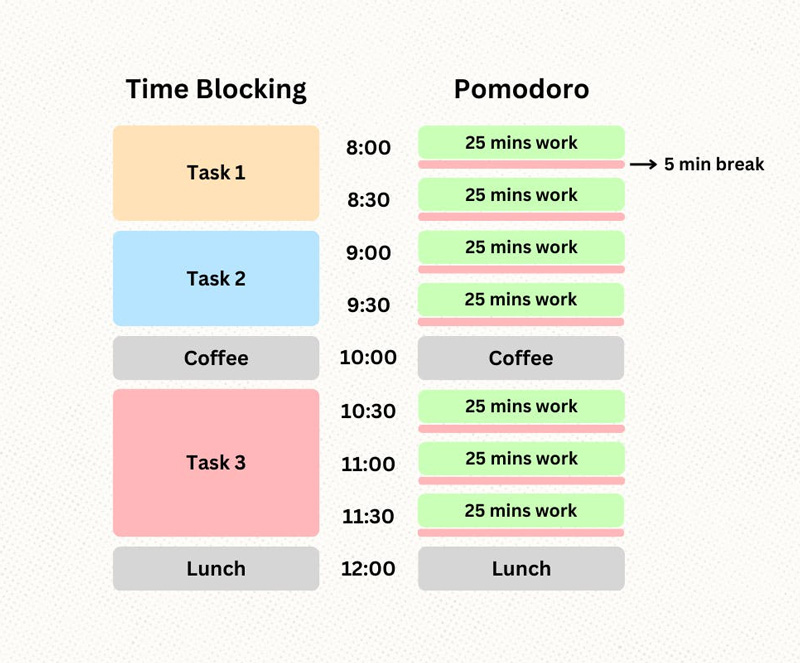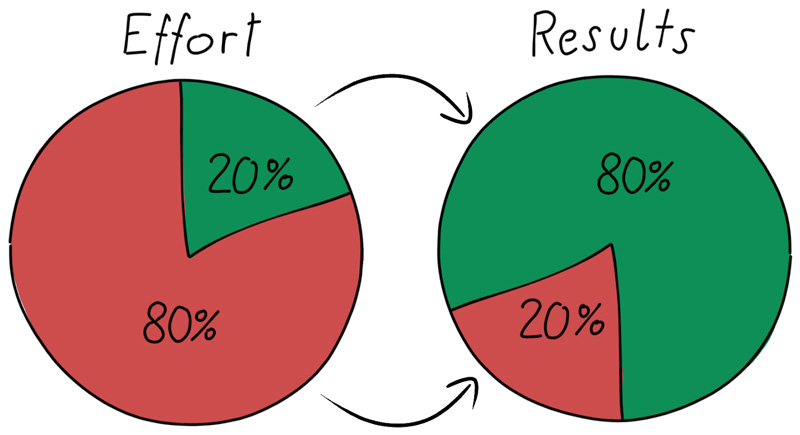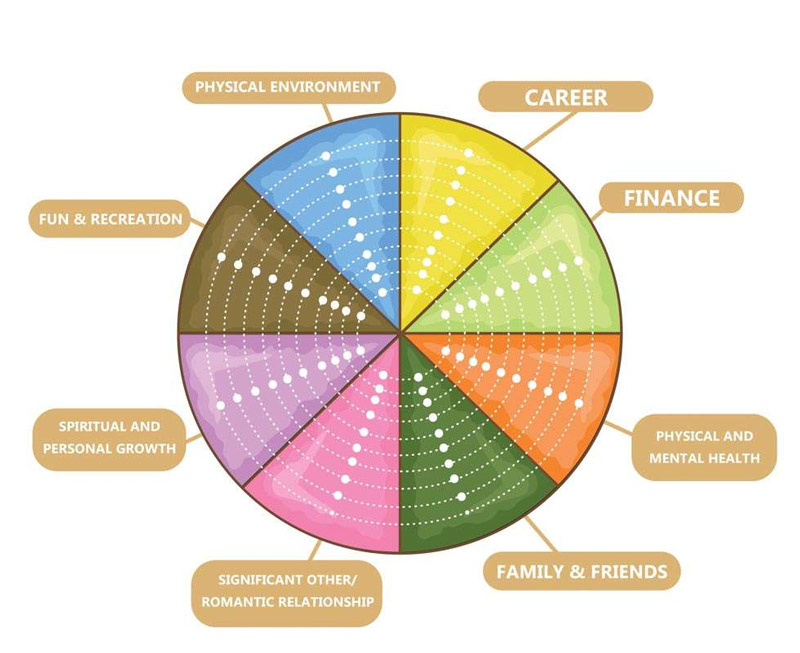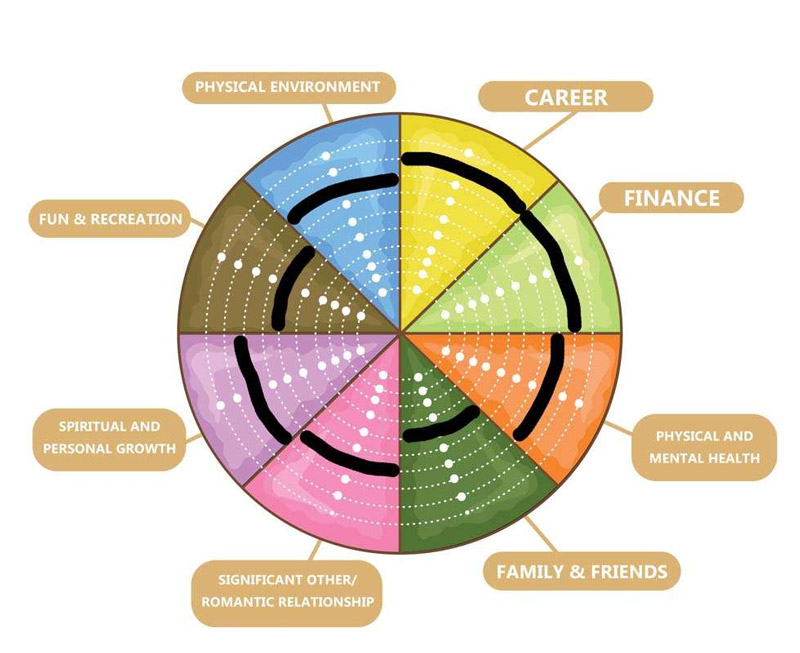Ever feel like you’re juggling a million things while building your business?
Starting a new business is an exciting journey, but it comes with its fair share of challenges.
As a new entrepreneur, you’re likely handling multiple things—marketing, finances, customer relations—all while trying to keep your sanity intact.
That’s why mastering effective time management and productivity is key to navigating these hurdles and staying on track.
To help you succeed on your entrepreneurial journey, here are ten practical, evidence-based productivity tips to boost your focus and make a real difference:
1. Balance Your Day Job and Side Hustle with Strategic Time Management
Many entrepreneurs start their journey while still working a full-time job, and balancing both can be tough. But there are two techniques that, when combined, can help make it manageable: Time Blocking and the Pomodoro Technique.
Let’s explore how each works and why they complement each other so well.
Time Blocking
Time Blocking is the process of breaking your day into chunks and assigning specific tasks to each one. Think of it as creating a budget, but for your time instead of your money. This method ensures you have dedicated slots for both your day job and side hustle, giving each focused attention.
The Pomodoro Technique
The Pomodoro Technique involves working in short, focused bursts (typically 25 minutes) followed by a 5-minute break. It helps prevent task switching, a major productivity killer. It keeps your concentration and energy high throughout your work sessions.
Combined, these methods give you an effective way to stay productive. They help cut down on multitasking, keep distractions in check, and build in much-needed rest. So you stay sharp and avoid burnout all day long.
So, how can you implement this combination?
- Use Time Blocking to plan your day by setting aside specific time slots for each task. Make sure to carve out dedicated blocks for your side hustle around your full-time job hours.
- Within each block, use the Pomodoro Technique: work for 25 minutes, then take a 5-minute break. Feel free to adjust the session lengths to what works best for you. Some people find that longer stretches help them get into a better flow.
- At the end of the day, take a moment to think about what went well and what could use some adjusting. Use these insights to fine-tune your approach and keep boosting your productivity.

2. Set a Structured Schedule When You Quit Your Job
Transitioning from a 9-to-5 job to the freedom of entrepreneurship can make it challenging to maintain a routine. Without structure, it’s easy to lose focus and spend time on low-priority tasks.
One effective approach to setting a structured schedule for your day is to separate planning from doing. To do this, you can use a mental model called “The Pilot, the Plane, and the Engineer.”
Here’s how it works.
The Pilot
First, be The Pilot—the one who sets your course for the day. Spend around 10% of your time in this role, deciding what to focus on. This could be done during your morning coffee, where you plan the day from a high-level perspective.
The Plane
Then, switch to The Plane for about 85% of your time. This is when you execute the Pilot’s plan. Your only job here is to execute the plan without overthinking, stay on course, and avoid distractions.
The Engineer
Finally, spend about 5% of your time as The Engineer, the one who maintains and optimises your systems. This includes organising your calendar, managing files, or even improving skills like typing speed, which makes you more efficient over time.
The Pilot ensures your output is useful. The Plane maximises the amount of work done. The Engineer makes the process time-efficient.
3. Create a To-Don’t List
While a to-do list helps you keep track of the things you need to accomplish, a To-Don’t List is essentially a list of things you want to avoid.
Think of it as your personal ‘no-go zone’. It’s for habits or tasks that waste your time, kill your productivity, or just don’t add to your well-being.
Research shows our willpower is limited. Every decision we make, like resisting a sugary snack or not checking Facebook, uses up mental energy.
A To-Don’t List helps by making those choices in advance, so you’re not constantly battling temptation. You’ve already decided what’s off-limits, so you save your energy for what really matters.
To make your own To-Don’t List, take a few minutes each week to review your habits and identify what’s dragging you down or doesn’t align with your goals. It could be as simple as “Don’t check social media before noon” or “Avoid multitasking during important tasks.” Post the list somewhere visible, and you’ll have a daily reminder of what to skip.
Here are five ideas to get you started on your list:
- Multitasking: It usually just means doing a lot of things poorly. Instead, focus on one task at a time.
- Saying “yes” to everything: This is a quick way to lose control of your time. Learn to say ‘no’ to things that don’t support your long-term goals.
- Endless meetings: They can be huge time-wasters. It’s better to only meet when necessary and keep it short.
- Constant email checking: It interrupts your focus. Try checking emails just 3-4 times a day.
- Morning scrolling: Starting your day on your phone sets you up for distraction. Instead, use that first hour for something productive or mindful.
As Idowu Koyenikan says, “Where your attention goes, your time goes.”
4. Follow The Pareto Principle
Back in 1906, Vilfredo Pareto made an interesting discovery while pottering in his garden. He noticed that about 20% of his pea pods were producing 80% of the peas. Curious, he wondered if this 80/20 rule applied elsewhere. So, he dug into wealth distribution data in Italy and found that 20% of the population owned 80% of the land. This was a lightbulb moment for Pareto. He began spotting this pattern everywhere.
For example, in business, around 20% of clients often generate 80% of the profits. In software, fixing 20% of the bugs can solve 80% of the issues. And the list goes on and on.
The numbers 80 and 20 aren’t exact, but the idea is that a small number of things often lead to the majority of results.

So, if you want to boost your productivity, think about focusing on the 20% of tasks or activities that bring the most benefits.
For example, if you have a to-do list of 10 tasks, tackling just two of those (the critical 20%) might deliver 80% of the value. This could be finishing a major project or scheduling an important meeting. Instead of getting overwhelmed by all 10 tasks, start with those two key ones to make the biggest impact.
Remember, this doesn’t mean ignoring the other 80%; they still matter. But knowing where to put your extra effort can make you feel more effective and satisfied with how you spend your time.
It’s about working smarter, not harder.
5. Leverage the Power of Delegation and Automation
Many entrepreneurs fall into the trap of thinking they need to handle every task themselves. But, trying to do it all can lead to burnout and inefficiency. A study by Gallup found that CEOs who effectively delegate tasks tend to achieve faster business growth and higher revenue than those who try to manage everything themselves.
To delegate effectively, try using the Eisenhower Matrix to categorise your tasks. This productivity approach was developed by US President Dwight D. Eisenhower, to help him manage the huge demands of the job
Quadrant 1: Urgent and Important (Do it Now)
These are your crisis tasks that need immediate attention, like a looming project deadline. Block out time in your schedule to handle these right away.
Quadrant 2: Important but Not Urgent (Plan to Do it)
These tasks are crucial for long-term growth but don’t have an immediate deadline, like improving your skills through an online course. Schedule regular time slots to work on these.
Quadrant 3: Urgent but Not Important (Delegate It)
These tasks seem urgent but don’t significantly impact your goals, like responding to non-essential emails that someone else could handle. Delegate them whenever possible.
Quadrant 4: Neither Urgent nor Important (Eliminate It)
These activities don’t contribute to your goals and should be minimised or cut out completely, like scrolling through social media during work hours. Use app blockers or set time limits to stay on track.

The Power of Automation
Besides delegating and deleting, there’s another action you can take to save time: automating.
Routine tasks can eat up a lot of your day. So automating them can save you time and help you focus on more strategic work.
Tim Ferriss, in The 4-Hour Workweek, highlights how automation can minimise your workload and maximise productivity, allowing you to focus on what truly matters.
You can use tools like Zapier, IFTTT, and HubSpot to handle repetitive tasks like email responses, social media posting, and customer follow-ups.
But automation isn’t just for the office. It can also simplify your daily routine and free up more time you can dedicate to growing your business. Here are some easy ways to automate your life:
- Set up automatic bill payments for utilities
- Use grocery delivery services
- Invest in a robot vacuum or cleaning service
- Subscribe to services for essentials like toiletries
- Use scheduling tools for recurring appointments
- Automate emails with templates
- Create a smart home setup with automated lighting, thermostats, and air purifiers
Remember, finding the right automation setup takes some trial and error. So, don’t be afraid to experiment. Start small, see what works, and tweak as needed.
6. Embrace failure
If you’ve ever made pancakes, you know the first one usually isn’t perfect. Either the pan’s not hot enough, the batter’s not the right consistency, or you simply decide to sacrifice it as a “test” pancake.
That’s what people in the cooking world know as the “First Pancake Theory”: the idea that the first attempt at anything new often doesn’t turn out great.
So, how does this relate to entrepreneurship?
Like pancakes, the first try at a new task or the first time you talk to a client may be messy. But that’s okay.
We often fear failure, but seeing early attempts as experiments can help turn them into valuable learning experiences. A bad first pancake doesn’t mean a bad batch. it’s just part of the process.
This aligns with the “fail fast, fail forward” approach from John C. Maxwell’s Failing Forward. It encourages rapid prototyping and experimentation, so you don’t run away from failure but make it your friend. The key is to see early failures not as setbacks but as stepping stones to improvement and eventual success.
7. Cultivate a Growth Mindset
A fixed mindset is the idea that all of your abilities, like your intelligence or your ability problem solve are set as they are. There’s not a lot you can do to change them.
Whereas, a growth mindset, as coined by psychologist Carol Dweck, means believing that your abilities and intelligence can be developed through effort and learning. It’s the idea that everything is a skill and can be improved over time.
Having a growth mindset means accepting that talent exists – but also accepting that you can succeed in almost anything you put your mind to.
You think you aren’t charismatic enough to sell your products? Go learn charisma. Struggling with managing finances or negotiating deals? Take a course or find a mentor. Not tech-savvy enough to build a website or handle digital marketing? Dive into online tutorials or hire an expert and learn from them.
The point is, no skill is off-limits. As an entrepreneur, the belief that you can learn anything gives you the freedom to tackle new challenges and develop the skills needed to succeed.
Every weakness becomes an opportunity for growth, and every challenge becomes a chance to expand your capabilities.
8. Infuse Fun into Your Work Routine
Running a business can be tough, but it doesn’t have to be all work and no play. As my book Feel-Good Productivity explains, adding fun to your routine can boost creativity, motivation, and overall well-being.
Science agrees: play releases dopamine, making work more enjoyable and opening up our minds to new possibilities.
So, here’s how to infuse fun into your work, even when tackling the most boring tasks. I like to call these techniques The Three Avenues to Fun.
- Ask yourself, “What would this look like if it were fun?”
- Turn goals into ‘quests’
- Set yourself a challenge
Avenue 1: Ask yourself, “What would this look like if it were fun?”
When facing a draining task, ask yourself, “What would this look like if it were fun?”. This simple question can transform boring work into something more enjoyable.
For example, instead of working at a desk, consider moving to a coffee shop, listening to your favourite music, or turning the task into a game. Think about changing your environment, involving a friend, or rewarding yourself after completing the work.
By finding ways to make tasks more engaging, you can boost motivation and make even the most monotonous activities more bearable.
Avenue 2: Turn goals into ‘quests’
To make goal-setting more engaging, consider turning your objectives into “quests.”
For example, instead of setting a target like “Increase client acquisitions by 20%,” call it “Quest for New Allies.” Or, if your goal is to reduce costs by 15%, name it “The Great Savings Hunt.”
This playful approach can shift your mindset, making goals feel more like exciting challenges rather than routine tasks.
Avenue 3: Set yourself a challenge
Another way to make tasks more enjoyable is to gamify them. Just like video games use points and level-up bars, setting personal challenges can add a fun twist to any goal. Compete with a friend, set targets (e.g., reach 30 potential clients in 10 hours), or use the Seinfeld Strategy to build an unbroken streak.
These challenges create a sense of accountability and satisfaction, helping you stay motivated and avoid procrastination.

9. Join A Coworking Group to Beat Isolation
Running a startup can get pretty lonely, especially if you’re a solo entrepreneur. Over time, this isolation can impact your mental health, motivation, and productivity.
A great way to beat this is through coworking. It provides a sense of community, networking opportunities, and a change of scenery that can help you stay focused.
Coworking works because it’s designed around the idea of social facilitation, where being around others boosts your productivity.
Research by psychologist Robert Zajonc supports this, showing that performance improves when working alongside others.
If a physical space isn’t an option, online communities like my new space Productivity Lab give you that same social vibe and accountability without leaving home.
10. Don’t Forget Self-Care (To Avoid Burnout Early)
Entrepreneurship often means long hours and high stress. So taking care of yourself is crucial to staying productive over time. It’s easy to think that working non-stop is the way to succeed, but this often leads to burnout.
To maintain your productivity, I suggest focusing on three key areas of self-care: physical, social, and mental. Let’s explore how to look after each one effectively.
Physical Self-Care
Taking care of your body is essential if you want it to function at its best. There’s a strong connection between body and mind, so when you care for your physical health, your mental clarity and overall well-being improve as well.
Here are some of the most effective ways to look after your body:
Food
What you eat has a huge impact on brain health and performance, thanks to the brain-gut axis. Basically, your brain and gut are in constant communication. If you’re struggling with focus, procrastination, or low mood, your diet could be to blame.
The Western Diet, low in fruits and vegetables and high in saturated fats, salt, and sugar, is pretty bad for the brain. On top of increasing the risk of cardiovascular disease and obesity, studies show that the Western diet leads to decreased cognitive function. It can even contribute to neurodegenerative conditions like dementia.
So, what’s the alternative?
Experts suggest putting an end to the burgers, soft drinks and other tasty stuff and transitioning to what’s known as a Mediterranean diet.
This diet is – unsurprisingly – inspired by the food of the Mediterranean. It consists of a lot of fruits and vegetables, whole grains, nuts, fish, olive oil, beans, lentils, tofu, chickpeas, eggs, oatmeal, avocado and basically other plant-based foods.
It’s not just good for reducing the risk of diabetes and cancer. It’s the ultimate fuel for the brain, improving memory, reducing the risk of neurodegenerative diseases, and boosting cognitive function.
Think of it as premium oil for your brain—switching to this diet can sharpen your focus, clear brain fog, and enhance mental performance.
Sleep
Research increasingly shows that a good night’s sleep does wonders for productivity.
Take, for example, one study with over 4,000 U.S. workers, which found that those who slept less experienced reduced productivity, performance, and safety at work. This was costing an estimated $1,967 per worker due to poor sleep.
Yet, what’s the main culprit behind the lack of sleep? According to another study, work overload.
It’s a chicken-and-egg situation: we’re less productive because we’re sleep-deprived, and we’re sleep-deprived because we’re trying to do too much.
Sleep specialist Dr. Matthew Carter highlights this paradox in his TEDx talk “The Science of Sleep (and the Art of Productivity),” stressing that “you’re able to get more done on a good night’s sleep, not less.”
Ariana Huffington, too, has been a vocal advocate for prioritising sleep. She’s shared her insights in a TED Talk and authored a best-selling book. She notes that achievement and rest aren’t at odds but actually reinforce each other.
Prioritising rest isn’t a luxury—it’s a necessity for sustaining your well-being and productivity in the long run.
Exercise
Physical activity can boost brain function by increasing the production of BDNF, a protein that helps with learning, memory, and higher thinking. The more you move, the more BDNF your brain produces, which is why exercise improves cognitive function and memory.
But it’s not just about what exercise you do. It’s also about how much and how often you do it.
Some studies suggest that exercise that includes open skills, like badminton, where you’re reacting and responding to things, increases BDNF more than closed skills, like running, where you’re repeating the same action over and over.
So, if you think of exercise as “I’ve got to go for a two-hour run,” know there are many other options. You can actually play football or badminton or do anything that moves your body and gets you enough exercise volume.
As Katy Bowman explains in her book Move Your DNA, exercise is only one form of movement. Getting a standing table, walking to work, or stretching while watching Netflix are other forms of exercise that can add movement to your daily life.
Social Self-Care
Humans are wired to connect with others, so taking care of your social life is key to feeling good.
But let’s be real—sometimes, it feels impossible to make time for friends when life gets busy, and it’s easy to convince yourself that you don’t really need it. That’s a lie. Socialising is a crucial part of self-care. Hanging out with friends, spending time with family, or just chatting with someone who gets you helps boost your mood and reduce stress.
So, make it a point to schedule regular social time. Grab coffee with a friend, join a fun group or class, or have a weekly game night. Even a quick text or call can do wonders.
Mental Self-Care
Looking after your mental health is just as important as staying physically fit. Simple practices like mindfulness, meditation, or just taking a few deep breaths can make a big difference in managing stress and anxiety.
Research even shows that these habits can improve focus and help you bounce back from challenges.
Try carving out some time each day for whatever helps you relax, whether that’s journaling, practising gratitude, or diving into a hobby you love.
Taking care of your mind isn’t a sign of weakness. It’s actually one of the smartest things you can do to stay sharp and productive.
How To Achieve Life-Work Balance
In the end, self-care is all about finding the right balance in life. But how do you know which areas of your life are thriving and which might need a little extra attention?
That’s where the Wheel of Life comes in.
The idea is to imagine your life as a wheel. This wheel is divided into sections that contribute to your overall life balance and happiness, such as health, career, relationships, personal growth, finances, fun, and so on.

Now, imagine that one section of your wheel is ‘pumped up’. For example, you’re killing it in your career, but another section (like relationships or health) is ‘deflated’. If that’s the case, your life wheel isn’t going to roll smoothly.
This is where the magic of the Wheel of Life comes into play. It gives you a visual representation of where you’re thriving and where you might need to add some air.
To put this exercise into practice, follow these two simple steps:
- Rate your level of satisfaction with each area of your life on a scale of 1 to 10.
- Once you’ve got your scores, you plot them on the Wheel of Life. It will look something like this:

Seeing those areas where your score is low can be an ‘aha’ moment, as those are the areas where there’s room for improvement.
Pour your energy into all spokes of your life wheel. Neglecting one for too long might give you a bumpy ride. Giving them all some love will help you cruise smoothly towards your goals.
Building Your Productivity Toolkit
Navigating the early stages of entrepreneurship can be overwhelming. But by incorporating these 10 productivity strategies, you can work smarter, avoid burnout, and stay on course to achieve your business goals.
Remember, you don’t need to implement all these tips at once. Think of them as tools in your toolkit—experiment with different techniques, and through trial and error, you’ll find what works best for you.



